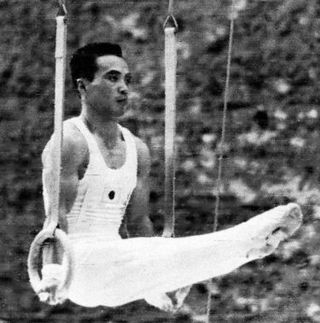At the 1988 Summer Olympics, two different gymnastics disciplines were contested: artistic gymnastics and rhythmic gymnastics. The artistic gymnastics events were held at the Olympic Gymnastics Hall in Seoul from September 18 through 25th. The rhythmic gymnastics events were held at the same venue from September 28 through 30th.
These are the results of the women's vault competition, one of six events for female competitors in artistic gymnastics at the 1960 Summer Olympics in Rome.
These are the results of the men's floor competition, one of eight events for male competitors in artistic gymnastics at the 1960 Summer Olympics in Rome.
These are the results of the women's floor competition, one of six events for female competitors in artistic gymnastics at the 1960 Summer Olympics in Rome.

The men's rings competition was one of eight events for male competitors in artistic gymnastics at the 1960 Summer Olympics in Rome. It was held on 5, 7, and 10 September at the Baths of Caracalla. There were 129 competitors from 28 nations, with nations in the team competition having up to 6 gymnasts and other nations entering up to 2 gymnasts. The event was won by Albert Azaryan of the Soviet Union, the first man to successfully defend an Olympic title in the rings. Boris Shakhlin took silver, making it the third consecutive Games the Soviets finished in the top two. Takashi Ono tied with Velik Kapsazov for bronze, giving Japan its second consecutive Games with at least one bronze medal and Bulgaria its first medal in the rings.
These are the results of the women's uneven bars competition, one of six events for female competitors in artistic gymnastics at the 1960 Summer Olympics in Rome.
These are the results of the women's balance beam competition, one of six events for female competitors in artistic gymnastics at the 1960 Summer Olympics in Rome.
These are the results of the women's vault competition, one of six events for female competitors in artistic gymnastics at the 1956 Summer Olympics in Melbourne.

The men's vault competition was one of eight events for male competitors in artistic gymnastics at the 1956 Summer Olympics in Melbourne. It was held from 3 to 7 December at the Melbourne Festival Hall. There were 63 competitors from 18 nations, with nations in the team competition having up to 6 gymnasts and other nations entering up to 3 gymnasts. The event was won by Helmut Bantz of the United Team of Germany and Valentin Muratov of the Soviet Union, who tied for the top place. Soviet Yuri Titov finished third to win the bronze medal.
These are the results of the men's floor competition, one of eight events for male competitors in artistic gymnastics at the 1956 Summer Olympics in Melbourne.
These are the results of the women's uneven bars competition, one of six events for female competitors in artistic gymnastics at the 1956 Summer Olympics in Melbourne.

The men's horizontal bar competition was one of eight events for male competitors in artistic gymnastics at the 1956 Summer Olympics in Melbourne. There were 63 competitors from 18 nations, with nations in the team competition having up to 6 gymnasts and other nations entering up to 3 gymnasts. The event was won by Takashi Ono of Japan, with his countryman Masao Takemoto taking bronze. Silver went to Yuri Titov of the Soviet Union. Japan and the Soviet Union each earned their first horizontal bar medals.

The men's rings competition was one of eight events for male competitors in artistic gymnastics at the 1956 Summer Olympics in Melbourne. It was held from 3 to 7 December at the Melbourne Festival Hall. There were 63 competitors from 18 nations, with nations in the team competition having up to 6 gymnasts and other nations entering up to 3 gymnasts. The event was won by Albert Azaryan of the Soviet Union, the nation's second consecutive victory in the rings. Another Soviet, Valentin Muratov, took silver. Masumi Kubota and Masao Takemoto earned Japan's first medals in the event, tying for bronze.
These are the results of the women's artistic individual all-around competition, one of six events for female competitors in artistic gymnastics at the 1956 Summer Olympics in Melbourne.
These are the results of the women's balance beam competition, one of six events for female competitors in artistic gymnastics at the 1956 Summer Olympics in Melbourne.

The men's parallel bars competition was one of eight events for male competitors in artistic gymnastics at the 1956 Summer Olympics in Melbourne. It was held from 3 to 7 December at the Melbourne Festival Hall. There were 63 competitors from 18 nations, with nations in the team competition having up to 6 gymnasts and other nations entering up to 3 gymnasts. The event was won by Viktor Chukarin of the Soviet Union, the nation's first victory in the parallel bars. Japan took three medals: a silver by Masumi Kubota and bronzes by Takashi Ono and Masao Takemoto. It was the third time a nation had won three medals in the event in the same Games: the United States had swept the medals in 1904 and Switzerland had earned a gold and two bronzes in 1948. Chukarin was the third man to win multiple medals in the parallel bars; Ono would become the fourth in 1960.

The men's pommel horse competition was one of eight events for male competitors in artistic gymnastics at the 1956 Summer Olympics in Melbourne. It was held from 3 to 7 December at the Melbourne Festival Hall. There were 63 competitors from 18 nations, with nations in the team competition having up to 6 gymnasts and other nations entering up to 3 gymnasts. The event was won by Boris Shakhlin of the Soviet Union, the nation's second consecutive victory in the pommel horse. Takashi Ono earned Japan's first medal in the event with his silver. Soviet Viktor Chukarin became the first man to win multiple medals in the pommel horse, adding a bronze to his 1952 gold.
These are the results of the men's team all-around competition, one of eight events for male competitors in artistic gymnastics at the 1960 Summer Olympics in Rome.
The women's artistic team all-around competition, one of six events for female competitors in artistic gymnastics at the 1960 Summer Olympics in Rome, was held at the Baths of Caracalla from 6 to 8 September. It was the 6th appearance of the event.
These are the results of the men's team all-around competition, one of eight events for male competitors in artistic gymnastics at the 1968 Summer Olympics in Mexico City.



